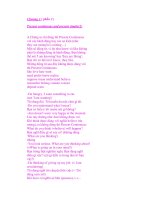Gerund and present participle
Bạn đang xem bản rút gọn của tài liệu. Xem và tải ngay bản đầy đủ của tài liệu tại đây (9.15 KB, 2 trang )
Gerund and present participle
The gerund and the present participle have identical forms. They are both formed from verbs and end in –ing.
However, they have different uses. A gerund functions like a noun. It can do everything that a noun does. A
participle, on the other hand, functions like an adjective. It is mostly used to modify nouns. It is also used to make
continuous tense forms.
Compare:
He kept me waiting. (Waiting – present participle)
I don’t like waiting. (Here the –ing form waiting is the object of the verb like and hence it acts like a noun. It is
therefore a gerund.)
After playing for an hour, he went home. (Playing – present participle)
Playing is good for health. (Here the –ing form playing is the subject of the verb is and hence it acts like a noun. It
is therefore a gerund.)
Forms of gerund
Having worked for twelve hours, I felt tired. (Perfect – active)
She is angry about having been criticized. (Perfect – passive)
Everybody is desirous of being praised. (Passive)
Not knowing what to do, she started crying. (Negative)
Exercise
Say whether the –ing forms given in the following sentences are gerunds or present participles.
1. Telling lies won’t help anyone.
2. She was punished for coming late.
3. Children learn reading and writing at school.
4. Coming events cast their shadow.
5. He left the tap running.
Answers
1. Telling – gerund (subject of the verb won’t)
2. Coming – gerund (object of the preposition for)
3. Reading and writing – gerund (object of the verb learn)
4. Coming – present participle (modifies the noun events)
5. Present participle – running (modifies the noun tap)
Stay on top of your writing! Download our grammar guide from www.englishgrammar.org to stay up-to-date.
Powered by TCPDF (www.tcpdf.org)









